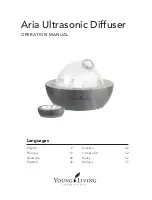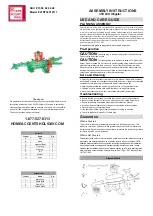
3
SM_150707_A
Service Manual IDYLLE since year 2014
Negative Spring:
A negative spring functions to control the return of the suspension when it reaches full extension. Negative springs can
be air, coil spring, rubber bumper or a combination of both. A negative spring also functions to soften the “top out feel” when the
wheel/suspension rapidly extends and it also helps initiate compression providing a smoother or more sensitive initial feel. An adjustable
negative spring offers the greatest tuning range for rider’s weight, for example a heavy rider will need a higher or stiffer spring to resist
pre-compression, but the high spring rate may also completely compress the negative spring rendering it ineffective to control top out.
Open Bath Dampers:
Open Bath refers to a cartridge that is NOT closed and allows oil to flow from the inside of the damper to the outside
of the cartridge or inside of the fork legs. Open Bath Dampers use oil for damping, lubrication, cooling, and end stroke “ramp up” or
“progression”. But the downside of all this oil is the added weight of all the excess oil that is used to fill the entire fork leg.
Packing:
An issue caused from too much rebound damping. When a series of bumps are encountered, the suspension doesn’t rebound
fast enough to absorb the next bump. The suspension keeps compressing more and more after each bump and it gives the rider a very
harsh feeling and even loss of traction and control because the wheels no longer follows the contour of the terrain.
Platform Damping:
A platform is generally referred to as resistance to initial suspension compression usually generated by pedaling or
rider induced forces. A platform can be achieved by various methods and usually the best way to limit suspension “bobbing” is to restrict
oil flow through the low speed circuit. Depending on what technology you have and there are various designs out there, choking off the
low speed circuit can be achieved by either adjusting a pressure spring on the shim stack, adjusting the depth of a bleed needle or changing
the size of an orifice via a slide. These are just a few of the most common methods to deliver platform damping feel to improve pedaling
efficiency.
Rebound Damping:
Once your suspension has hit a bump and compresses, now it’s time for your rebound damping to kick in. Rebound
controls how fast the fork extends back from compression to keep the wheel on the ground. Rebound can affect your traction as well. Too
much rebound damping will keep the suspension compressed when it should be extending to stay on the ground on the downside of a
bump, and the wheel will lose contact with the ground. This is called “Packing”. Too little rebound damping will cause the suspension to
“bounce” and “hop” also causing a loss of traction and control. Proper rebound control is equally important as compression and it is very
important to properly tune this performance feature. The rebound valve is best located on the “MV” with a tapered shim stack controlling
oil flow. Damping systems that use orifice or small holes to control damping simply cannot control the dynamics of high performance
suspension.
Spring Preload:
The preload ring or collar compresses the shock or fork spring and either shortens or extends the spring to its original
length. Preload is used to adjust the suspension to the correct range of operation within the suspension’s travel- more spring preload will
the raise the bike up and less preload will lower it.
Spring Type:
Springs can either be coil or air and both are widely used in mountain bike suspension systems. Springs work to resist pre-
compression of the suspension under the rider’s weight and is independent of the compression system which refers to damping. Too stiff
of a spring rate delivers a harsh and uncontrolled feel, if your spring rate is too soft, the suspension will sit too far into its travel and will
feel mushy and easily bottom out. It’s important to have the correct spring rate for each rider and setting up “SAG” will determine whether
you have the correct rate or not.
Stiction:
Or static friction, is a term that describes friction that occurs from parts rubbing or gliding across one another. For example, on
both the rebound and compression stroke, the stanchion tubes must glide against the bushings, O-rings, seals, and other parts. The parts
that come in contact with one another create friction and when a bending load is applied the stiction can increase causing the suspension
to bind and feel notchy. Stiction can also dramatically increase after seals become dry resulting in the loss of small bump sensitivity.
Twin Tube Dampers:
Twin Tube systems generally combine the technology of an “Open Bath” Damper and a “Closed Cartridge” system.
With a Twin Tube design, the cartridge damper is inside of a tube (hence twin tube) allowing oil to flow from the cartridge damper into
and from the twin tube providing additional oil flow and damping performance without the added weight of “excess” oil that is needed to
fill the fork leg.
Valving:
The mechanical hardware that creates compression or rebound damping. Valving is a combination of check valves, holes, ports,
shims, springs, etc. The best valving arises out of piston with a series of tapered shim stacks which are very thin high quality steel “washers”
that when combined together produce a smooth yet linear flex pattern when oil flows around them. Shims provide the resistance to the
oil flowing through the piston at various speeds. The lower amount of shims used typically means the damping quality is less. Systems that
use one or two shims deliver a harsh feel on high speed hits, unfortunately, many so-called high performance suspension designs use very
few shims and/or only small holes to control damping forces. If your clickers are ineffective or have a very small range, this is due to
improper piston & shim stack design.






































